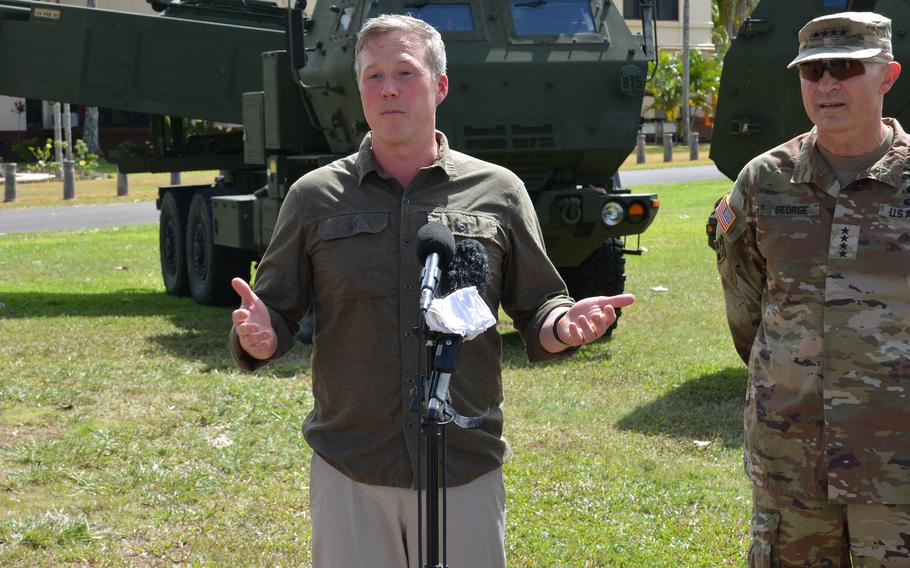
Army Secretary Daniel Driscoll and the service's chief of staff, Gen. Randy George, speak with reporters near a pair of HIMARS launchers at Schofield Barracks, Hawaii, on July 22, 2025. (Wyatt Olson/Stars and Stripes)
SCHOFIELD BARRACKS, Hawaii — In the not-too-distant future, the Army will field blended human-machine squads that mimic the stuff of science fiction, Army Secretary Daniel Driscoll told reporters Tuesday at this Honolulu installation.
“I think what you will see in a couple of years when you drive back on this base is you’ll see an infantry squad vehicle going out into training with some autonomously led robots beside it, and some drones that are capable of swarming flying above it,” he said. “And I think you’ll start to see this mixture of human and machine in a way that used to be kind of science fiction — but we’re right on the edge of it.”
Driscoll arrived Monday in Hawaii on a trip that will also take him to Australia and the Philippines. He was joined at Schofield Barracks by Army Chief of Staff Gen. Randy George and Maj. Gen. Marcus Evans, commander of the Hawaii-based 25th Infantry Division.
The 25th ID is one of three divisions at the forefront of the Army’s “Transforming in Contact” initiative, which aims to rapidly put the newest technology into the hands of soldiers to make them more lethal, survivable and adaptable in any environment.
As part of that initiative, 25th ID is taking delivery of 16 High Mobility Artillery Rocket System, or HIMARS, launchers this summer as the Army moves to increase the firing range and mobility of its Pacific ground forces. At the same time, the division is divesting itself of 14 howitzers.
Driscoll said he was talking with soldiers to better understand their combat needs in furtherance of Transforming in Contact.
“What the soldiers were telling us is a lot of the equipment we’ve been giving them for the last decade or two — the Humvees, the [joint light tactical vehicles] — it just doesn’t work in this terrain,” he said. “When they’re deploying to the Philippines, it doesn’t work.”
Last fall, 25th ID fielded about 100 of the Army’s new infantry squad vehicles, which allowed small formations of soldiers to transit the battle space more nimbly and with greater stealth.
“They love them,” Driscoll said of the feedback soldiers gave him.
Driscoll said the Army’s budget for the upcoming fiscal year will “massively invest in our data layer.”
A data layer refers to a structured approach to managing and sharing data from various sources that can be quickly integrated, analyzed and made available to users.
A more robust data layer “will allow our things to communicate with our sensors and communicate with our people in near real time,” Driscoll said.
“If you look at the commercial sector, a lot of what’s going on with electronic vehicles is they became software manifesting in the world as the vehicle,” he said. “And we, the United States Army, have to do the same thing.”
Soldiers can expect “all sorts” of autonomous systems that can coexist with human-led systems, Driscoll said.
“It’s going to allow us to use generative [artificial intelligence] to help us with things like our air and missile defense and our offensive targeting,” he said. “It’s going to basically allow the human being to be enabled and empowered with digital tools in a way that we are not all the way scaled with right now.”